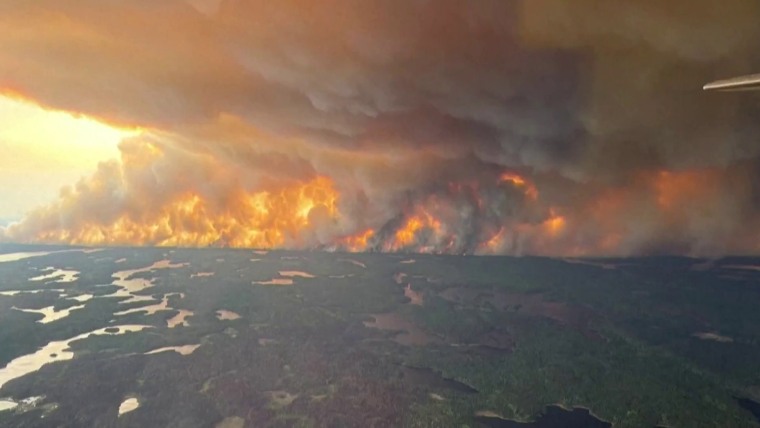Regional Air Quality Report: Inland Northwest
Current Status and Impact on Sustainable Development Goals (SDGs)
An assessment of air quality in the Inland Northwest region indicates a deterioration, with direct implications for several United Nations Sustainable Development Goals (SDGs). The Spokane Regional Clean Air Agency has reported the following:
- Current Air Quality Index (AQI): The AQI in Spokane is currently 80, classified as “Moderate.”
- Impact on SDG 3 (Good Health and Well-being): Moderate air quality poses a health risk, particularly to sensitive groups. This condition challenges the goal of ensuring healthy lives and promoting well-being for all at all ages.
- Impact on SDG 11 (Sustainable Cities and Communities): Elevated pollution levels detract from the goal of creating safe, resilient, and sustainable urban environments. Clean air is a fundamental component of a sustainable community.
Causal Factors and Environmental Implications
The primary factor contributing to the decline in air quality is the prevalence of regional fires. This situation highlights critical environmental challenges related to the following SDGs:
- SDG 15 (Life on Land): The fires indicate pressures on terrestrial ecosystems. Sustainable forest management is crucial to mitigate wildfire risk and protect biodiversity.
- SDG 13 (Climate Action): Increased frequency and intensity of wildfires are linked to climate change. This event underscores the urgent need for climate action to combat global warming and its impacts.
Forecast and Public Health Advisory
Official agencies have issued advisories and forecasts in response to the current and anticipated conditions. These measures are essential for protecting public health and advancing SDG 3.
- Projected Worsening Conditions: Air quality is forecast to decline further, potentially reaching the “Unhealthy” category on Wednesday and Thursday.
- Official Alerts Issued: Air Quality Alerts are now in effect for numerous areas, including Spokane County, Stevens County, and most of Eastern and Central Washington.
- Public Health Imperative: These alerts serve to inform residents so they can take necessary precautions, directly supporting the public health targets within SDG 3.
Monitoring and Alignment with Global Goals
Continuous monitoring and public information are critical for managing the public health impacts of poor air quality. The situation in the Inland Northwest serves as a local case study on the interconnectedness of environmental health and global sustainability targets.
- Addressing the root causes of wildfires is essential for long-term progress on SDG 13 (Climate Action) and SDG 15 (Life on Land).
- Effective public health advisories and air quality management are direct actions that contribute to achieving SDG 3 (Good Health and Well-being) and SDG 11 (Sustainable Cities and Communities).
Analysis of Sustainable Development Goals in the Article
1. Which SDGs are addressed or connected to the issues highlighted in the article?
-
SDG 3: Good Health and Well-being
The article’s primary focus is on the deterioration of air quality and its potential health impacts. Phrases like “worsening air quality” and the possibility of it falling into the “unhealthy” category directly relate to environmental health risks that affect human well-being.
-
SDG 11: Sustainable Cities and Communities
The issue is discussed within the context of a specific urban and regional area, “Spokane” and the “Inland Northwest.” The article highlights an environmental challenge affecting the quality of life in these communities, which is a core concern of SDG 11.
-
SDG 13: Climate Action
The article identifies “regional fires” as the cause of the poor air quality. Wildfires are a climate-related natural hazard, and their increasing frequency and intensity are often linked to climate change. The issuance of “Air Quality Alerts” is a response to such a hazard.
-
SDG 15: Life on Land
The “fires burning in parts of the Inland Northwest” directly impact terrestrial ecosystems, forests, and biodiversity. This connects the issue to the sustainable management of forests and the protection of land-based ecosystems.
2. What specific targets under those SDGs can be identified based on the article’s content?
-
Target 3.9
“By 2030, substantially reduce the number of deaths and illnesses from hazardous chemicals and air, water and soil pollution and contamination.” The article’s concern about air quality reaching “unhealthy” levels directly aligns with the goal of reducing illnesses caused by air pollution.
-
Target 11.6
“By 2030, reduce the adverse per capita environmental impact of cities, including by paying special attention to air quality and municipal and other waste management.” The article focuses specifically on the air quality in Spokane, a key metric for measuring the environmental impact of the city on its residents.
-
Target 13.1
“Strengthen resilience and adaptive capacity to climate-related hazards and natural disasters in all countries.” The regional fires are a climate-related hazard, and the issuance of “Air Quality Alerts” represents an adaptive measure to help the population cope with the consequences.
-
Target 15.2
“By 2020, promote the implementation of sustainable management of all types of forests, halt deforestation, restore degraded forests and substantially increase afforestation and reforestation globally.” The existence of “regional fires” implies challenges related to forest health and management, which this target aims to address to prevent such events.
3. Are there any indicators mentioned or implied in the article that can be used to measure progress towards the identified targets?
-
Air Quality Index (AQI)
The article explicitly mentions the “current air quality in Spokane is 80” and uses categories like “Moderate” and “unhealthy.” The AQI is a direct indicator used to measure air pollution levels and is relevant for tracking progress on Target 3.9 and Target 11.6.
-
Existence of Early Warning Systems
The mention that “Air Quality Alerts are in effect for most of Eastern and Central Washington” serves as an indicator of the presence and activation of early warning systems. This is a key measure for assessing progress towards Target 13.1, which focuses on building resilience to climate-related hazards.
-
Occurrence of Regional Fires
The article’s statement that “fires burning in parts of the Inland Northwest are playing a factor” implies that the frequency, extent, and intensity of wildfires can be used as an indicator. A reduction in such fires would indicate progress towards the sustainable forest management goals of Target 15.2.
4. Summary Table of SDGs, Targets, and Indicators
| SDGs | Targets | Indicators |
|---|---|---|
| SDG 3: Good Health and Well-being | 3.9: Substantially reduce the number of deaths and illnesses from air pollution. | The Air Quality Index (AQI) value (mentioned as “80”) and its classification (“Moderate,” “unhealthy”). |
| SDG 11: Sustainable Cities and Communities | 11.6: Reduce the adverse per capita environmental impact of cities, paying special attention to air quality. | Monitoring of air quality within a specific city (Spokane) and region (Inland Northwest). |
| SDG 13: Climate Action | 13.1: Strengthen resilience and adaptive capacity to climate-related hazards. | The implementation of “Air Quality Alerts” as an early warning and adaptive response system. |
| SDG 15: Life on Land | 15.2: Promote the implementation of sustainable management of all types of forests. | The occurrence of “regional fires,” which implies a lack of or challenge to sustainable forest management. |
Source: krem.com







